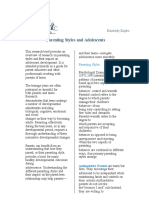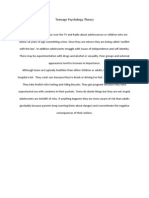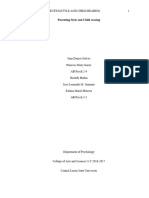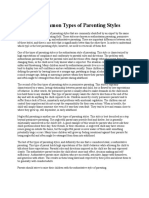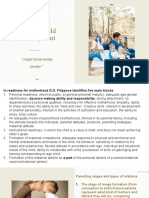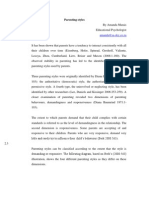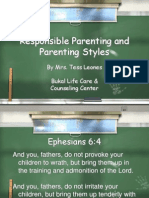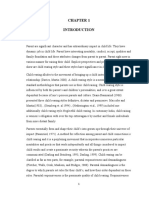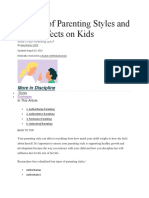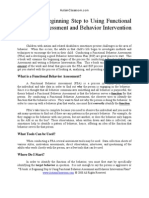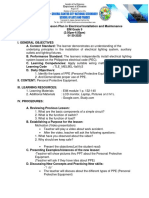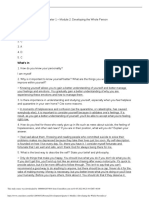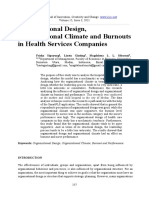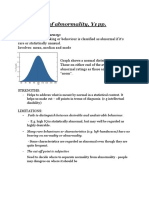Parenting Pattern/Styles
Parenting Styles
Psychologist Diana Baumrind (1971, 1991) identified four patterns of parenting styles based
upon two aspects of parenting behavior: control and warmth.
Parental control refers to the degree to which parents manage their childrens behaviorfrom
being very controlling to setting few rules and demands.
Parental warmth refers to the degree to which parents are accepting and responsive of their
childrens behavior as opposed to being unresponsive and rejecting. When the two aspects of
parenting behavior are combined in different ways, four primary parenting styles emerge:
1. Authoritative Parents (also called moderate, flexible, backbone)
are warm but firm. They encourage their adolescent to be independent while maintaining
limits and controls on their actions. Authoritative parents do not invoke the because I said
rule. Instead, they are willing to entertain, listen to, and take into account their teens
viewpoint. Authoritative parents engage in discussions and debates with their adolescent,
although ultimate responsibility resides with the parent. Research demonstrates that
adolescents of authoritative parents learn how to negotiate and engage in discussions. They
understand that their opinions are valued. As a result, they are more likely to be socially
competent, responsible, and autonomous.
Possible outcomes:
For children, self confidence, success in school and the ability to make friends are
more likely
They more able to solve their own problems and learn from their mistakes
They tend to be more caring to others and less likely to bully
The children feel safe because theyve learned they can count on their parents to
be there to help if things go wrong
As teens, they tend to have lower levels of drug misuse and other risky behavior
and are less likely to be depressed.
2. Authoritarian Parents (also called brick wall)
display little warmth and are highly controlling. They are strict disciplinarians, use a
restrictive, punitive style, and insist that their adolescent follow parental directions.
Authoritarian parents invoke phrases such as, you will do this because I said, and
because Im the parent and you are not. Authoritarian parents do not engage in discussions
with their teen and family rules and standards are not debated. Authoritarian parents believe
the adolescent should accept, without question, the rules and practices that they establish.
Research reveals that adolescents of authoritarian parents learn that following parental rules
and adherence to strict discipline is valued over independent behavior. As a result,
�adolescents may become rebellious or dependent. Those who become rebellious might
display aggressive behaviors. Adolescents who are more submissive tend to remain
dependent on their parents.
Possible outcomes:
The children may have a hard time making their own decisions about right and
wrong in the future
They learn only how to obey, often out of fear, rather than learning how to make
good choiches about their own behavior.
These children may lack self confidence and independence.
The because I said so approach may lead to power struggles and rebellion in the
teen years.
3. Permissive Parents (also called lenient, jellyfish and marshmallow)
are very warm, but undemanding. They are indulgent and passive in their parenting, and
believe that the way to demonstrate their love is to give in to their adolescents wishes.
Permissive parents invoke such phrases as, sure, you can stay up late if you want to, and
you do not need to do any chores if you dont feel like it. Permissive parents do not like to
say no or disappoint their children. As a result, teens are allowed to make many important
decisions without parental input. Parents do not view themselves as active participants in
shaping their teens actions; instead they view themselves as a resource, should the
adolescent choose to seek their advice. Research findings show that adolescents of
permissive parents learn that there are very few boundaries and rules and that consequences
are not likely to be very serious. As a result, teens may have difficulty with self-control and
demonstrate egocentric tendencies that can interfere with proper development of peer
relationships.
Possible outcomes:
Children are often creative and confident
But to others they may appear impulsive and childish
They often dont accept responsibility for their own actions and blame others.
They may have have problems getting along with others
They may have have trouble following rules at school or work as they have not
had to do at home.
4. Uninvolved Parents
are not warm and do not place any demands on their teen. They minimize their
interaction time, and, in some cases, are uninvolved to the point of being neglectful.
Uninvolved parents are indifferent to their adolescents needs, whereabouts, or experiences
at school or with peers. Uninvolved parents invoke such phrases as, I dont care where you
go, or why should I care what you do? Uninvolved parents rarely consider their teens
�input in decisions and they generally do not want to be bothered by their teen. These parents
may be overwhelmed by their circumstances or they may be self-centered. Parents might
also engage in this style if they are tired, frustrated, or have simply given up in trying to
maintain parental authority. Research supports that adolescents of uninvolved parents learn
that parents tend to be interested in their own lives and less likely to invest much time in
parenting. As a result, teens generally show similar patterns of behavior as adolescents
raised in permissive homes and they may also demonstrate impulsive behaviors due to
issues with self-regulation.
Developmental psychologists overwhelmingly endorse authoritative parenting as the
optimal parenting style for raising adolescents (Steinberg, 2001).
Authoritative parenting is associated with healthy adolescent development and provides a
balance between affection and support and an appropriate degree of parental control in managing
adolescent behavior. This atmosphere provides opportunities for the adolescent to become selfreliant and to develop a healthy sense of autonomy within a set of parental limits, guidelines and
rules.
Although an authoritative parenting style is related to positive developmental outcomes,
many parents likely use a mixture of different parenting styles when parenting teens. For
example, a parent may be more permissive in allowing an extended weekend curfew, but more
authoritarian in disallowing their teen to ride in a car with friends after 11 p.m. Thus, parents
may modify their individual parenting style to fit particular circumstances.
Parenting styles may also differ between parents (e.g., one parent is permissive while the
other parent is authoritarian). In this situation, parents should discuss, in private, acceptable and
unacceptable teen behaviors and those areas where they can reach agreement in parenting their
teen. For example, if the teen breaks a curfew, both parents could agree on a consequence that
they are willing to enforce together, even if their individual parenting style may not warrant this
action. In the case of differing parenting styles, parents should aim for consistency in setting and
enforcing rules on specific teenage behaviors.
Adolescent behavior also influences parenting style. Whereas a cooperative, motivated, and
responsible teen may be more likely to have parents who exercise an authoritative parenting
style, an uncooperative, immature, and irresponsible teen may be more likely to elicit a parenting
style that is authoritarian or uninvolved.
Like most important topics in psychology, research on parenting styles is not immune to the
nature-nurture debate. Researchers who study parent-adolescent relationships are increasingly
looking at the importance of the impact of parenting on adolescent development, and how
experiences in the family and other contexts interact with genetic factors to influence behavioral
and developmental outcomes (Collins, Maccoby, Steinberg, Hetherington, & Bornstein, 2000).
References:
1. Kimberly Kopko.Parenting Styles and Adolescents. Cornell Cooperative
Extension.2007
�2. Durham Health Department.Parenting styles.2012.
